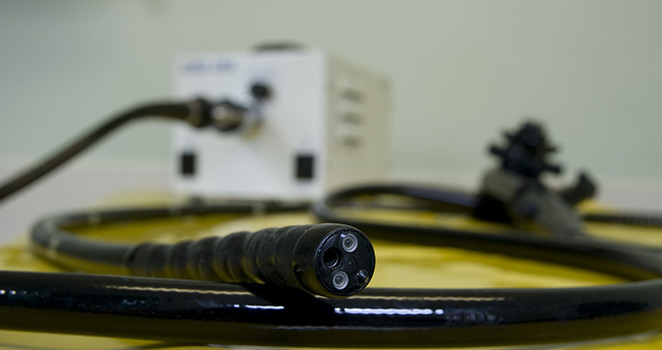Atrium Health Navicent Heart & Vascular Care
Bronchoscopy

Bronchoscopy in Heart and Lung Surgery
Bronchoscopy in heart and lung surgery is a procedure utilized to examine the inside of a person's lung airways. These airways medically are known as bronchi and bronchioles. These airways carry air from the windpipe or trachea to the lungs.
Use of Bronchoscopy
Bronchoscopy commonly is utilized as a diagnostic procedure. For example, is a person complains of a lung-related problem, a bronchoscopy is likely to be ordered by a doctor, according to the National Heart, Lung and Blood Institute. This oftentimes is referred to in the medical community as lung anatomy bronchoscopy.
In the alternative, a bronchoscopy can be utilized as part of a treatment or surgical procedure. Bronchoscopy in heart and lung surgery is a less invasive way of addressing certain types of conditions affecting one, another, or both of these organs.
If cancer is suspect in the lungs, a lung biopsy bronchoscopy can be performed. Through this procedure, a sample of the suspect tissue is removed from the lungs using a lung biopsy bronchoscope.
The Design of a Bronchoscope
A bronchoscope is comprised of a flexible tube. The tube itself is thin and comes complete with a light and a camera. The light and the camera permit a doctor the ability to see inside a person's trachea and lungs.
An alternative derivation of a bronchoscope is made of rigid rather than flexible tubing. This type of bronchoscope is used if a patient experienced heavy bleeding or has some sort of foreign object caught in his or her airway. A rigid bronchoscope permits a doctor the ability to remove a foreign object, if necessary.
The Bronchoscopy Procedure
If a flexible bronchoscope tube is utilized, a patient will not necessarily be under a general anesthesia. A local anesthetic will be sprayed into a person's throat to relax and numb the area. If a rigid tube is necessary, a patient will be under a general anesthesia.
The bronchoscope typically is inserted through a person's nose, through the airway, and into the lungs. If accessing the airway and lungs through the nose is not possible for one reason or another, the bronchoscope can be inserted through a person's mouth. A common reason for inserting the tube through a patient's mouth is the presence of a breathing tube in a person's nose. This would be the situation in the case of bronchoscopy in heart and lung surgery.
Preparing for a Bronchoscopy
A patient typically is directed to fast for six to 12 hours before a bronchoscopy. If the bronchoscopy is part of a surgical procedure, the fasting requirements of that procedure itself will also come into play. In addition, a patient will need to refrain from drinking any liquids for a set period before the procedure.
In advance of undergoing a bronchoscopy, a person is likely to be required to undergo a chest x-ray and specified blood work. This can be done any time in advance of the bronchoscopy.
Frequency of Bronchoscopy Procedures
Bronchoscopy is a widely utilized procedure. According to the National Survey of Ambulatory Surgery Reports, the rate of bronchoscopy procedures among men and women is similar, but with men undergoing the process with more frequency:
- Males: 10.6 per 10,000 population
- Females: 7.3 per 10,000 population
Side Effects of Bronchoscopy in Heart and Lung Surgery
Bronchoscopy is considered a generally safe procedure. Bronchoscopy side effects are usually minimal. Some hoarseness and a sore throat are common complaints following a bronchoscopy. However, these two issues typically are not significant and not long lasting.
There is a slight risk that a patient will experience some minor bleeding. Even less likely is the possibility of the development of a post-bronchoscopy fever or pneumonia. Very rarely, bronchoscopy can result in one or both lungs collapsing. In most cases, this proves easy to rectify. A person should contact a doctor immediately if he or she experiences these symptoms after a bronchoscopy:
- coughing up blood
- shortness of breath
- chest pain
- fever